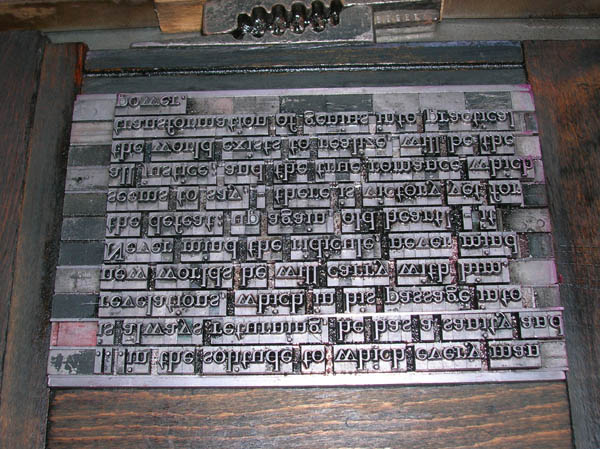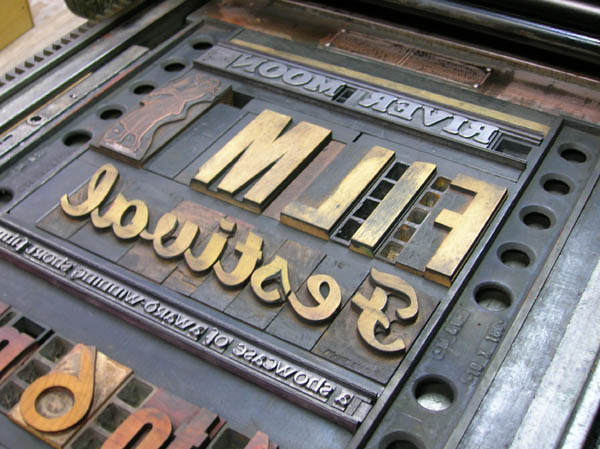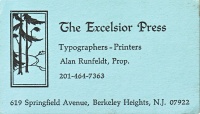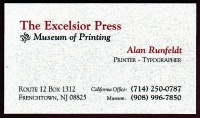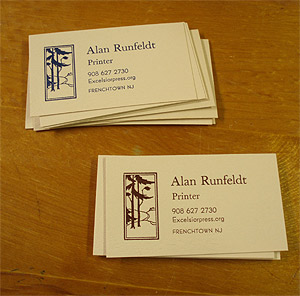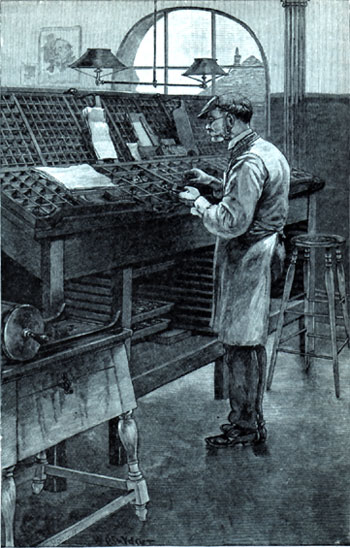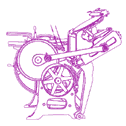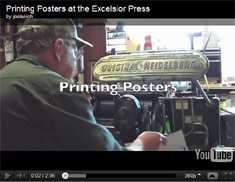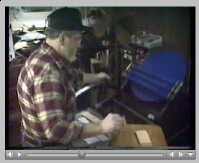Document Menu
Return to
Introduction - 1962
History of
Excelsior Press - 1962-1967
The
Excelsior Press Today - 1986-1997
How It was
Done - 1986-1996
The PEOPLE
of The Excelsior Press - 1975-1985
Smithsonian
Museum of American History Exhibit: Printing &
Graphic Arts
Lycos
search for "Printing History"
Links of Other websites of
interest to Letterpress Afficianados
goto Alan Runfeldt's
Website - 1995-2007
Contact
webmaster
|Menu| History of
Excelsior Press- 1962 - 1967
continuing from introduction..... Begin at Introduction ...
During the previous winter (1962), his father had
brought home a gift from a neighbor, William C.
Soper who had heard that this neighbor's son
wanted to be a printer. In his youth, the now retired
Mr. Soper had worked for the American Type
Founders Company. ATF was the major
manufacturer of printers high quality, hard-metal lead
type. The gift he sent over was a couple of peach
baskets filled with pied type - little lead letters
all jumbled up in a pile. 12 point ATF Goudy Oldstyle
and Italic - cast on a 14 point body. Easy to work
with, even for a novice. That winter, father and son
worked together, sorting out the letters into the
California Job Cases Mr. Soper had supplied.
� Now he was
ready to start printing. �
Some special neighbors knew of his interest in
printing. One of these neighbors was Mr. Spencer Brodney
an author who could be rightly described as "A
Victorian Gentleman", born in Brisbane, Australia in
the 1880's. Mr. Brodney's story - and that of his wife
Edith and his sons Kenneth and Richard, who became a
characters in the story of the Excelsior Press in
later years - is a tale of its own and deserves its
own web page.
� One day,
Spencer Brodney wrote a "Letter of Introduction" to
his friend Joseph
Ishill, proprietor of the private "Oriole Press".
Mr. Ishill and his wife, the poet Rose Freeman Ishill,
were personal friends of Frederick W. Goudy, one of America's
pre-emient typographers. They had known Mr. Goudy when
they both lived in Garden City, Long Island during the
1920's.
Mr. Ishill welcomed the young printer, but would not
let him actually enter the shop beneath his house
while he was working, so the young printer would stand
in the doorway, watch Mr. Ishill at work and listen to
the impromtu lectures that came from this interesting
old man.
Mr. Ishill did not earn a living as a printer; he had a
job of some sort - but nothing related to printing. He
loved printing too much, he explained, and wanted to
print what he chose to print, not what some paying
customer wanted. His advice was to avoid "job printing"
as printing for pay was called, and focus on the content
and design and purpose of the things to be printed.
During the 1920's and 30's, he had printed broadsides
for anarchists and union organizers and poetry and short
stories - some quite radical - for authors whose work he
respected. The result is a collection of beautiful small
books and pamphlets currently in the collection of the
library at Rutgers University.
Mr. Ishill printed on an old "Favorite" as well as an
Improved Pearl #8 - a 5x8 chase-sized press which is
currently in the collection of the Excelsior Press
Museum.
But although the young boy appreciated the advice and
understood its value, he did not follow it, but thought
instead that by doing job printing, he could acquire the
type and equipment and build a shop with which he could
someday print what he wanted as Mr. Ishill did.
� He wanted to be a
printer. If printing for pay could make that
happen, it was the path to follow...
As time went on, he learned about printing wherever
he could - mostly from old printers he met. � He spent one summer
visiting his grandmother in Florida and managed to
work his way into a part time job - mostly
sorting type and spaces - for a small print shop
called Pembroke Press. Pay was a Big Boy Hamburger and
large coke for lunch. He was satisfied; he was
printing and that Big Boy was the first hamburger he
had ever had that was served with lettuce and
mayonaise. Quite exotic.
When he left Pembroke Press, the proprietor insisted
on sending him on his way with a letter of
recommendation that said, in part that "(this boy) has
an interest in printing to the highest degree".
Strong words, but they stuck in his mind for the rest
of his life.
� When he was
fourteen, he had the opportunity to buy a "real"
full-sized printing press, a Chandler & Price
8x12 Platen Press. This press was not built for a boy
hobbiest, as was his Kelsey Excelsior, this press was
built for a man to operate, full time and at full
speed - about 30 impressions per minute. It was built
around the turn of the century, and was operated by a
foot treadle, as well as an add-on electric motor. � Along with this
press came an older (1870's-90's) Gordon press
built in New England by Damon & Peets.
There were also about fifty California job cases full
of old foundry type - including a complete selection
of Theodore Devinne's "New" Typeface from the
1890's, and a very full case of "Typewriter
Type" a mono-spaced font used to simultate
the style of a Typewriter - a modern machine during
that era. � These
presses and type were from a printing shop owned and
operated by Tony Rienzo who had used the shop
to support his family during the Great Depression of
the 30's, then closed the shop and left it in storage
for thirty years until he decided it was time to part
with the now obsolete equipment. None of the printing
businesses of the '60's had any interest in this old
letterpress equipment, so he offered to sell it all
for $400 to the boy who worked in the print shop
downtown.
That boy was fourteen year-old Alan Runfeldt, who
wanted more than anything to have his own type cases
and printing presses to begin his own career. He was
frustrated that, because of his age, he could not get
a "real" job in a printing shop, and was forced to do
menial clean-up and manual labor. � He wanted to "set
type and run a press" but there was no type to be set
in the mostly offset shops in the area, and the old
printers in the nearby city - those who still used
lead type - would not trust the work to a young boy.
So, at fourteen, Alan, encouraged and assisted by his
parents, loaded up the entire shop from the basement
of an old building in Jersey City, and unloaded it all
into the new basement of their home in the wooded Free
Acres section of Berkeley Heights. The Excelsior Press
began to grow. It was no longer a young boy with a
boy's toy printing press, but a real print shop
with real printing presses - somewhat
old-fashioned, but at last, he could set his own type
and print on his own printing presses. He couldn't get
a job doing what he wanted to do, so he equipped his own
print shop and went to work.
Three years later, he met Mr. Wallach, who
had equipped a basement print shop for his son, Ken -
a classmate of Alan's. Ken showed no interest in the
printing press and type, so it was offered for sale to
Alan. The equipement consisted of a 10x15 Chandler
& Price Platen Press and 48 cases of foundry
type, including a complete series of Goudy
OldStyle and Italic, from 6 to 48 point. The
cases were clean and enclosed in tight-fitting
dust-free Hamilton Cabinets which shone when
polished and oiled. The metal was fresh, hard ATF
foundry metal - not merely lead, but a unique alloy of
lead, tin and antimony - all mixed to exactly the
right percentage to make a type that felt right
in the typesetter's fingers.
to be continued.....
�1996-2007 Excelsior Press � TOP
� Contact
webmaster
TOP The Excelsior
Press Today- 1986-1996
Today
(1996) the Excelsior Press is resting in a barn on a
farm a few miles outside of Frenchtown, New Jersey.
Only a few miles from the Delaware River, the farm is
a tranquil place for a collection of old printing
presses and printers types. The shop "is a mess" and
everything needs to be cleaned and arranged. Some
presses have collected some rust, the paint is pealing
off of the Vandercook Proof Press, and the typecases
all need to be cleaned and the wood oiled. But this is
being done, slowly, but surely. The shop will be fully
functional and available to illustrate - hands-on -
just how a small print shop operated during the period
from 1900 to 1950. The 10x15 C&P and the
Heidelberg Windmill are fully operational and are
being used again. In 1995, the Heidelberg was used to
produce some beautifully embossed cards for The Knoll
Group, and the Windmill continues to crank out carton
upon carton of numbered and perforated receipt forms
every autumn, as it has since 1976..
UPDATES
update 12/27/2001:
After four months away from home this summer, it
finally dawned on me that I was 52 years old and had
been dreaming about resurrecting the old Excelsior
Press as a working shop for over 15 years... The
result was a resolve to walk away from this damned
computer and the internet for a few hours each day,
and head into the barn to putter and print.
Well, I'm happy to say that I've been doing just
that. The result can be seen in the photo links listed
at the top of this page.
The Vandercook Proof Press has been disassembled,
cleaned, lubricated, given a new set of soft rollers
and is once again in operation. It sure feels good.
* n.b. As of this writing, we are just completing the
2001/2002 "Dog License Season". We've been doing this
one job since 1976... twenty-five years. For
twenty-five years, my Thanksgiving, Birthday and
Christmas has been overshadowed by the pressing need
to get late orders processed and printed above all
else. No wonder I'm such a Scrooge. For weeks before
Christmas, my primary concern is to "print the dog
licenses" and Christmas always arrives as a surprise
to me...
But, now the Heidelberg is placed in a shop in barn
on a farm - with heat and insulation- and a fantastic
view of hay fields, the Delaware Valley, and The Hills
of Pennsylvania off in the distance. Sunsets are
amazing here, too. So these days, as I run my Windmill
and print these boring, mundane black on white
municipal forms, I gaze off into the distance at blue
skies and amazing sunsets.
It's fun to be a printer... and to be printing.
And now, once again, I'm beginning to print things
much more interesting than dog licenses!
- Alan - 12/27/2001
update 3/3/2006:
Apologies for the lack of updates in the past five
years... Life goes on and is very busy. But here I am
again, back at the keyboard, cleaning up old errors
and improving (hopefully) the look of the website.
Over the years since 2001, a lot has changed -
improved - at the Excelsior Press. It's really back in
operation and things are being printed now and then.
There's still a lot
of cleaning and organizing to be done, and much of the
equipment is still dirty and grimy and in need of
cleaning, but a lot of it is working as well. At least
I can go in there now and set type and print cards and
tickets and posters and such when I can find the time.
But it's a spring-summer-fall print shop. There is no
heat or insulation, so most actual printing is
curtailed during the New Jersey winter - when it's
generally below 45 degrees.
But I have been able to print on the C&P using a
new propane heater to warm up the ink table and the
old printer's trick of "the ink candle" - a thick
candle behind the ink table, keeping it warm in a cold
print shop... I learned that from Mr. Liberty in
1965. He learned it in Romania in the 1890's....
The exciting news from 2004 was Wayne Miller's video
of me at work cutting card stock and printing some
tickets and posters for the local Film Festival.
There's a link at the top of this page.
The big news for 2006 is the addition of a few more
hand presses and hot metal keyboard composition added
to our mostly foundry-type composing room. Barry Mueller has
sold his building and is bringing his Intertype and
his Linotype - and dozens of fonts - down to the
Excelsior Press for semi-retirement. Barry's been
running these machines for 20-30 years and he's coming
too - to teach me operation and maintenance of these
linecasters (something I've waited 40 years to learn)
and to do composition work for our projects.
We also picked up some type cabinets and some type
from Hobson Printing, in Easton, Pa. Hobson Printing
was founded in 1896 and did mostly letterpress
printing - books and such - almost until the end of
the last century. But the building was sold, and had
to be emptied. Some of their type and cabinets - and a
really neat wrapping paper dispenser have been added
to our collection.
Next chore is to
arrange for some projects to do...
update - May 2006
This week's news contains two stories -
The first is about a new printer - Amy, a graphic
designer from Ohio, who wanted her own press and is
intrigued about letterpress printing. Amy and her
husband Jason drove all the way out from Ohio to spend
a day at the shop, learning to print on her own 5x8
Kelsey Excelsior Press. The best part of the day was
when I saw that light go on in her eyes and her
sparkling smile of joy when she got the test print to
look good. Then she learned to set hand type and
printed a "Happy Mother's Day" card for her mother. By
the end of the all-too short day together. We got some
nice photos, too. Watch for them on our photos page
soon.
And, during the week before Amy's visit, we cleaned
up the back room and washed, etched and painted the
concrete floor - to hold down the all-too present dust
- and made room for Barry's equipment - the Intertype,
the Model 31 Linotype, his Model M Ludlow and his
as-yet unsold Heidelberg Windmill. They all arrived on
Tuesday - finally, after about two years' discussion,
the job is nearly done. All that we are waiting for is
the new 220 volt line to get power to this equipment.
Soon I'll be learning to operate the Linotype and
Intertype and we'll be casting slugs for our
Excelsior/Mercury Linotype Samples. And, once
everything is operational, we will be offering
Linotype and Ludlow Casting Services for other
printers as well!
(Now, if I can just get my friend Paul to part
with his Elrod at a good price, we'll be casting
leads, slugs and border materials as well.)
- Alan 5/13/06
update
5/6/2012:
Can it be? I have not updated this chronicle in six
years! What have I been doing? (Lots of stuff, but not
updating this page, obviously.) Well, the print shop
and web site have grown quite a bit during the past
six years. Updates can now be see on the blog pages which have
been chronicling much of what has happened since it
was begun in 2008. The blog pages also now serve as
links to new information being published on the site,
so it's worth a visit..
And, more news. (Gee, this is like a personal
diary...) Since 2006, the craft of letterpress - and
the skills and equipment needed to pursue the craft -
have again come into vogue. In fact, two years ago, a
nationally-recognized film maker made a documentary
about letterpress printing right here in the shop. Kiss
The Paper by Fiona Otway is
currently "on the festival circuit", and we are hoping
to see it on PBS some day. Our equipment has been
filmed by Discovery Channel, USA Networks, Doug
Audria, Wayne Miller and many visitors to the shop.
It's been quite a ride and has been lots of fun.
These days, we are restoring presses, tutoring new
printers, supplying starter kits and various used
equipment and supplies in small quantities to folks
who need it. We've also begun "consulting" on
letterpress printing as well as doing training and
servicing of old presses on site. It's nice to get out
now and then.
And of course, we are still printing - but now it's
both job printing to help pay the bills and (finally)
personal printing which is quite literally just for
fun. I make an effort to print something new every day
when I can. If not every day, at least one little
project a week - maybe just a proof, maybe a stack of
cards - what ever. But it's putting ink on paper
that's printing...
And it is still fun. Been at this craft off and on
for fifty years now, and to me printing is still
magical...
One of the printing projects in the shop, by the way,
is a catalog of well over 50 different photoengravings
and wood cuts that were used by The Kelsey Company in
their advertising from the 1870's through the 1990's.
These cuts are on loan from Gene Mosher, last owner of
the Kelsey Company. We are printing a catalog, then a
book using the original cuts that Kelsey used well
over a hundred years ago. Now, that's a
project!
- and we will shout it from the rooftops once it's
ready to share with the world.
- Alan Runfeldt
May, 2012
For further updates, see our blog pages
to be continued.....
�1996-2012 Excelsior Press � TOP
� Contact
webmaster
TOP The People of The
Excelsior Press - 1975-1985
THE PEOPLE
of the Excelsior Press are an important part of its
history. They are a collection of some very unique
individuals. There is something about a printing shop
which, throughout history - from Ben Franklin's shops
in the 17th century, to the Excelsior Press is the
1970's, which seems to attracts interesting
characters. Those who passed through the EP over the
years seemed to be aware that they had participated in
a special moment in history. They all seem to have had
a sense of "something special" about the EP and they
all made a personal contribution to its character,
reputation and history. The cast of characters
involved and where they are now would be the subject
of a small book. Perhaps we'll explore that in the
future, after the Web Site fulfills its main purpose:
� Documenting
and Illustrating the Techniques of Printing
Generally Employed in a sole-proprietor-sized
printing office of the first half of the Twentieth
Century
to be continued.....
continued January, 2014
Yes, it's been a while, but now it's time to
immortalize some of that great staff we've had at the
Excelsior Press since the days in the basement and up
to today, with the shop in the barn...
While in sixth grade, Ricky Ryan and I had my
little 3x5 Kelsey set up in a spare art room in the
basement of Columbia School in Berkeley Heights. Ricky
& I printed a few jobs for the school during our
art classes.
But the first actual employee of the Excelsior Press
was Charlie Bivona 1974. That was in the
basement shop at 362 Emerson Lane, in Berkeley
Heights, NJ - where the Excelsior Press began. Charlie
moved on before we set up shop in town, but apparently
he liked printing presses, stayed in close touch after
he got "a real job" and spent many years servicing -
and now selling - small offset presses here in New
Jersey.
Curt Nowell graduated high school with my
brother in 1974 and wanted something better than
continued work with his Uncle Dirk's landscaping
business; he wanted to learn an indoor trade and
started at The Excelsior Press while it was still in
the basement, was integral in the move and set up at
614 Springfield Avenue and stayed with the EP until
moving on to join our good friend John Brundo at
Bantam Press, where he managed production until John
retired and closed the shop a few years ago. When
Bantam shut down, Curt was quickly hired by our
combined best customer and continues to manage
printing production at MGL Printing Solutions. We work
together on projects to this day.
MGL Printing Solutions is the evolved name of MGL
Forms-Systems, founded by Matthew G. Lowe in
1975 or so - when he was just out of college. As the
business grew, he hired his brothers and a cousin and
developed a wonderfully successful family business.
Now, many years later, we still do one particular
large annual printing job for MGL as we have been for
nearly 40 years...
Mike Ryan was also fresh out of high school
and in need of some direction - and a job. As an
artist, he had always enjoyed graphics and printing,
and he quickly took to setting foundry type and making
up metal letterpress forms. Mike did proofs and
production work on the Vandercook Model 4 Proof Press
we still use to this day. In his honor, it is named
"The Michael Ryan Memorial Proof Press"... Mike moved
on to working in an engraving shop, then computer
graphics and web development.
Mark Powell worked at the EP summers while he
was in college. He not only enjoyed the regular job
work we produced, but enjoyed doing his own projects
as well. Mark completed college and medical school,
married his college sweetheart and they opened their
own Family Practice in Pennsylvania and raised a bunch
of neat kids. We stay in touch now via Facebook...
During the summer of 1977 or '78, Mark and Cathy
Rutigliano pretty much ran the entire business
and kept the Excelsior Press serving the community
while I was off on a travel adventure to California
and preoccupied with other issues.
Noel Shaw was an experienced pressman who we
met through our friend and fellow printer, Al Beckman.
Noel could run any machine he was put in front of and
made our little ATF Chief 15 perform like a smaller
version of the large presses Noel had been running in
the bigger shops. When it came to servicing the
machine, he was not afraid to strip it down to its
component parts, repair what needed repairing and
reassemble the press and get back to printing in an
amazingly short time. Noel later ran his own shop in
California, then followed me into web development
during the mid 1990's before following his own dream
and becoming a sea captain, a trade he plies now
throughout the world, but particularly enjoys his own
"Delivery Skipper" business which includes sailing and
delivering beautiful yachts throughout the east coast
and the Caribbean... The adventures of
"Tall Sailor" can be followed on Facebook.
Greg Daniels was an experienced printer and
friend of one of our clients. Greg arrived shortly
before we got the Heidelberg Windmill, but was
familiar with all aspects of letterpress and offset
printing and managed the hand type, the C&P and
the ATF Chief 15 quite well when he worked part time
in the first shop during the 1970's. Later, he
returned full time to run the Heidelberg in the
enlarged shop we moved into in 1979 - when we got the
Windmill. I was very frustrated at the time to finally
own my own Windmill, but not have the time to run it.
As owner of a 7-person shop running two shifts, I had
my hands full and had to hire a pressman to run my
dream platen press. Greg was an experienced Windmill
operator and took great care of the press, did fine
press work and taught me the importance of setting
aside time each day for cleaning and preventive
maintenance.
Tom Coyne was still in high school when he
came to the Excelsior Press as a customer - he needed
to find someone to print his underground newspaper
"The Dood"... He needed printing; we needed more help;
it was a natural match. We enjoyed the brilliant
creativity and cheerful spirit of Tom Coyne for quite
a few years - summers mostly, before he went off to
college. He eventually married a girl who worked for
one our clients and last we heard from him, he was
managing a large computerized typesetting computer
system for a major publisher.
Mary Ellen Szper was managing the local
McDonald's restaurant when she discovered the
Excelsior Press and made a career change to something
more to her liking... As an artist, she liked all
things graphic. As a craftsman, she loved setting type
and printing on the old letterpresses. As an
experienced manager, she organized the shop and made
it profitable. She was a big part of the Excelsior
Press for many years and finally left and wound her
way west where she became a very successful graphic
designer. She returned to visit a few times in the
past years as she now wends her way around the
continent in her new RV, "Painting her way Across
America"...
Sherry Allen arrived one day and said she
wanted to learn more about printing. She had already
run an AB Dick 360, but we had only an ATF Chief
offset, and two operators for it. M.E. took her under
wing and taught her to use the darkroom camera, set
hand type and run the letter presses. Sherry was a
part of the team for a year or two before moving on.
David Powell - Mark's brother - liked what
he'd heard about working at the EP and came for a job
in the early 1980's. It worked out well. Dave was an
integral part of the staff and named his favorite
press - our 12x18 Chandler & Price "Big Ben".
After he moved on to work at an engraving shop, he
engraved a name plate for his press, which sits on it
now in the museum print shop. Dave also worked for a
time at Bantam Press and is currently an executive at
a major printing firm.
Russ Letieq was a friend of Mark and David
Powell, had been operating an engraving press in
Mountainside, but decided, based upon Mark's
suggestion, that working at the EP would be a good
thing. We were fully staffed when Russ made his offer
to work for two weeks at no pay to let us see how he
fit in. Fit in, he did. As Tom Coyne would say
"Indeed". Russ was the last full-time employee of the
Excelsior Press as we shut down operations in Berkeley
Heights, moved briefly to Plainfield, then "retired"
the collection of antique presses to the barn where
the Excelsior Press Museum Print shop now resides.
Russ went on to buy his own over-the-road tractor,
settled down, married Sue, and continues to earn his
way hauling large trailers here and there around the
country. Russ came to visit the shop a few years ago
and printed some campaign posters for his wife's run
for town council. (She won.)
Howard Henson never worked at the Excelsior
Press, but he is an integral part of its history,
nonetheless. Howard worked for the sons of the man who
bought the rights to "The Little Rascals" short movies
back in the 1940's. We printed the sales sheets that
he used to sell these shows to local tv stations
throughout the country. The business relationship was
good and one day we were asked to design and print a
spiffy new letterhead for King World Productions. It
was this job that let us move up from using a borrowed
AM Multilith 1250w to purchase our own more advanced
ATF Chief 15 offset press. Eventually, Howard just
sort of moved in and became part of the family...
arriving at the shop after he left his office at five
and staying until it was time to pack it in for the
day.
Back around 1979, HH spent months using our
computerized typesetting system to prepare a very
professional presentation for a pitch to Billy Joel
which included the unique idea of a tv channel
presenting nothing but music videos 24x7. The idea did
not sell, and Howard did not make a million dollars.
But a few years later, MTV hit the scene and proved
him prescient in his concept... Howard eventually left
the area and moved to New York City - the urban center
which suits his interests and personality.
==============
Today. Today, the Excelsior Press does not
hire people. I found years ago that managing a staff
is a full time responsibility and a lot to handle.
It's easier to work alone. I get far less done, but
life is much, much simpler for me...
But, instead of brilliant staff, we now have
brilliant students who come to the shop to learn what
they can about letterpress printing for their own
purposes. During the past few years, we have trained
dozens and dozens of folks how to set type and print -
on the Vandercook, the hand presses and the
Heidelberg.
Many of them would have fit in well with the
historical EP staff and many of them have assisted as
informal interns for short periods. Although managed
by one individual these days, the Excelsior Press has
too much to offer to keep it all for one person to
enjoy alone. We welcome visitors and students -
especially first-time printers - and love to see the
look of wonder and pride in their eyes as they print
perhaps their first piece on a letter press.
Their stories are pretty much told among the pages of
the Excelsior Press blog..
Update December 27, 2001.
A few months ago, we had the sad news that one of our
Excelsior Press alumni, Mike Ryan, suffered a heart attack and
died at 46. Mike first came to the Excelsior Press
just out of high school, when his father strongly
suggested that he "get a job and learn a trade". Well,
Mike learned the trade of letterpress printer at the
Excelsior Press. Mike set type, designed printing
jobs, and operated the Vandercook Proof Press. He
printed most of the pages of the engravings catalog of
the Excelsior Press.
After he left the Excelsior Press, Mike went on to
become a graphic designer and was most recently
involved in designing and creating websites on the
internet - a far cry from hand-set type, but a natural
progression - and one which has been followed by many
of us who used to set all their type by hand from the
California job case...
We had hoped that Mike would be able to visit the
Museum frequently, and continue his cataloging of the
boxes and boxes and trays and trays of engravings,
wood type and various ornaments in our collection.
Alas, life was too short for that. Instead, we will
continue his project for him.
In what we feel is fitting tribute to Mike and his
time at the Excelsior Press, our Vandercook, the 1946
Model 4 Proof Press currently being restored, is being
christened "The Michael Ryan Memorial Proof Press".
It might seem odd to have a press named in someone's
honor, but discussion with Mike's friends and other
members of the Excelsior Press Alumni have convinced
us that Mike would have liked that, and his mother was
deeply touched when told of our plans. So. We are
having a brass plaque engraved with his name and will
mount it on the press as a part of the restoration.
We'll also be collecting and scanning some images of
Mike to add to this website in the future.
- ar 12/27/2001
Update October 23, 2007
Last Saturday, we had a visit from
one of the Excelsior Press Alumni. Russ Letieq wanted
to print some campaign posters for his wife Sue who is
running for town council in Glendon, PA. We had a
wonderful time playing with the wood type and the
Vandercook and made some nice posters for Sue. We have
some photos which we will hopefully post on page of
their own some time soon...
Update May, 2012
During
the past year, we've had two more very special
alumni visitors; Mary Ellen Szper went on to a
very successful career as an artist - practicing
both commercial and fine art and making
quite a name for herself in California.
She
bought herself an RV last year and decided to
spend a year "or so" on the road - seeing old
friends and "painting her way across the country",
so to speak. And that's what she's doing right
now. She stopped by the farm last summer and
parked her RV out by the north field for a few
weeks of painting in a bucolic setting before
continuing her adventure and heading south
"towards Mexico", but seems at this time to be
having too much fun in Florida to leave The
Sunshine State. It was good to have her back, even
just for a time. She was likewise pleased that The
Excelsior Press survives. But she was not
surprised...
Then, back in March, Dave Powell stopped by. There's
a blog post
about his visit... He was a young boy, new to printing
when he came to us. Now he's a grown man and has been
very successful in life and in the printing industry.
It's guys like Dave that make us proudest of all...
�1996-2007 Excelsior Press � TOP
� Contact
webmaster
TOP HOW PRINTING WAS
DONE -1900-1950
THIS SECTION was
intended to offer links to explanations of how
printing was done in the small letterpress print shop
of 1900-1950. These techniques are being practiced
today in museum exhibitions, as well as by hobby
printers and private presses throughout the world.
However, over the years, it simply has not been
done. Meanwhile, many other printers have done a fine
job dealing with this subject. I'll add links here to
their sites as we find them. (Suggestions welcome)
| If you have a particular interest, and
can't find information here, (this is
a long-term project....) Please ASK
and I will be happy to answer your questions
and turn my writing to your subject if I
can. |
The Skills of
Letterpress Printing fall into three major
categories;
- Typesetting and Composition
- Setting Lead Type
- Casting Ludlow
- Inserting "Cuts" (pictures)
- Press work (Printing)
- Lockup
- The Chase
- The Form
- Furniture
- Makeready
- Printing (Running the press)
- Bindery (All post-press work)
- Cutting
- Padding
- Stitching
- Packaging
�� All of the
above subjects (and more!) must be mastered by the
printer in order to take a job from beginning to
end. In the larger shops, these skills became
specialized and split up among different craftsmen -
eventually, even different unions. � But, for the "job"
shop of the early 20th century - and even back to
Ben Franklin's - or even Gutenberg's times, A
"Printer" was a complete master of his trade only if
he could follow every step in the design, production
and packaging of printed material. ��
to be continued.....
�1996-2014 Excelsior Press � TOP
� Contact
webmaster

Sarah and Jenet "kicking the treadle" on the old Gordon Jobber - accompanied by Rich (Frontroom Press) on the guitar.
